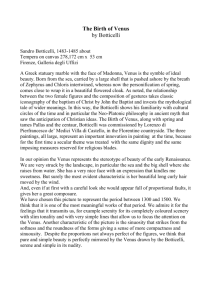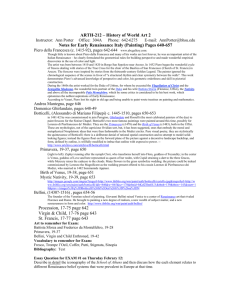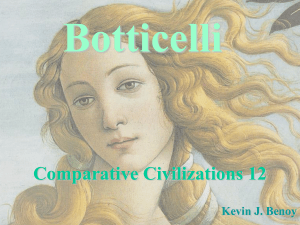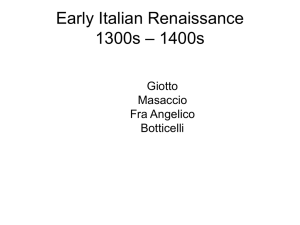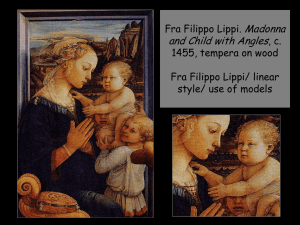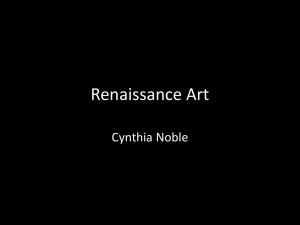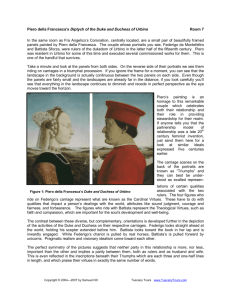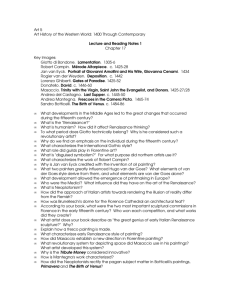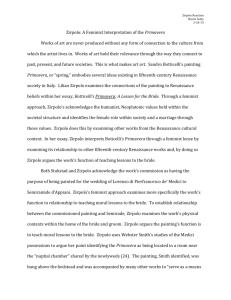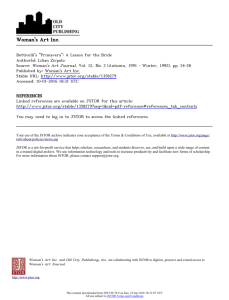this lesson
advertisement
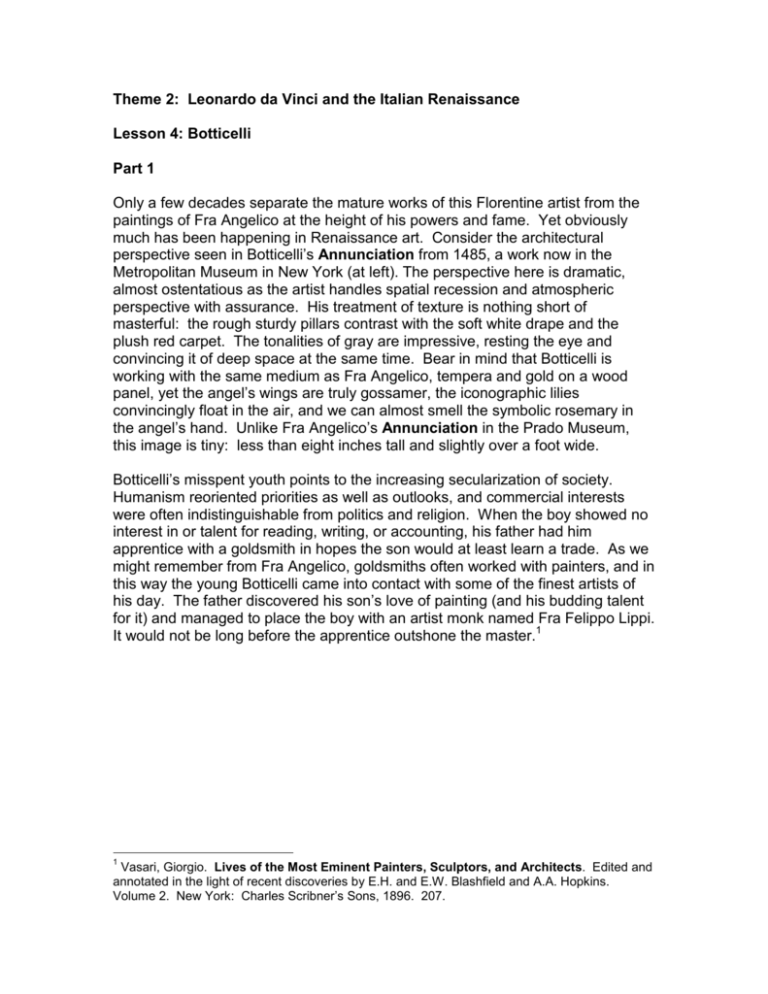
Theme 2: Leonardo da Vinci and the Italian Renaissance Lesson 4: Botticelli Part 1 Only a few decades separate the mature works of this Florentine artist from the paintings of Fra Angelico at the height of his powers and fame. Yet obviously much has been happening in Renaissance art. Consider the architectural perspective seen in Botticelli’s Annunciation from 1485, a work now in the Metropolitan Museum in New York (at left). The perspective here is dramatic, almost ostentatious as the artist handles spatial recession and atmospheric perspective with assurance. His treatment of texture is nothing short of masterful: the rough sturdy pillars contrast with the soft white drape and the plush red carpet. The tonalities of gray are impressive, resting the eye and convincing it of deep space at the same time. Bear in mind that Botticelli is working with the same medium as Fra Angelico, tempera and gold on a wood panel, yet the angel’s wings are truly gossamer, the iconographic lilies convincingly float in the air, and we can almost smell the symbolic rosemary in the angel’s hand. Unlike Fra Angelico’s Annunciation in the Prado Museum, this image is tiny: less than eight inches tall and slightly over a foot wide. Botticelli’s misspent youth points to the increasing secularization of society. Humanism reoriented priorities as well as outlooks, and commercial interests were often indistinguishable from politics and religion. When the boy showed no interest in or talent for reading, writing, or accounting, his father had him apprentice with a goldsmith in hopes the son would at least learn a trade. As we might remember from Fra Angelico, goldsmiths often worked with painters, and in this way the young Botticelli came into contact with some of the finest artists of his day. The father discovered his son’s love of painting (and his budding talent for it) and managed to place the boy with an artist monk named Fra Felippo Lippi. It would not be long before the apprentice outshone the master.1 1 Vasari, Giorgio. Lives of the Most Eminent Painters, Sculptors, and Architects. Edited and annotated in the light of recent discoveries by E.H. and E.W. Blashfield and A.A. Hopkins. Volume 2. New York: Charles Scribner’s Sons, 1896. 207. Part 2 In the images created by Botticelli we find full expression of the Renaissance principles of harmony, proportion, and unity. The painting becomes a balanced whole. Everything we see within the image, however pleasing in itself, is an element at the service of the entire composition. These principles may strike us as rather abstract, remote, cold. In fact, we have been brought up—educated—to look for them and to respond positively to them. Think of synonyms for harmonious and you will find that it actually rubs up against the other principles: not only pleasant, agreeable, peaceful, calm, matching, corresponding, but also well-balanced, well-proportioned, unified…, bringing us around to notions of proportion and unity. The same holds true for synonyms of the latter words. All three Renaissance principles form an integrated paradigm and really express different aspects of the same ideal. We must bear in mind that Renaissance ideals did not always match Renaissance realities. It was a turbulent and often violent age, as noted previously. People were dirty and smelled bad. Due to poor diet and worse hygiene, illness and deformity and death were visible everywhere. Secularization created new tensions in a society once dominated by church and nobility. Justice in the city-states, like everything else, had much to do with your rank and pocketbook. Botticelli had the good sense to be born into a well-off family, and his talent brought in money. At least as long as he kept painting. “A weave r of c loth onc e came to live next to Sandr o [Botticelli], and t his man erect ed eight full l ooms, which, w hen a l l were a t work, not only ca used an intolera ble d i n with t he trampling of the weavers and the clang of the s huttles, insomuch t hat poor Sandro w as de a fened by it, but likewise p roduced such a t rembl i ng and s haking throughout t he house, which wa s non e too sol idly built, that th e painter could no long e r contin ue his work, nor ev en remain inside t he ho u se. He had frequently requ ested his neighbor to p u t an end to this disturbanc e, but th e latter r eplie d that he both could and wou ld do wha t he pleas ed in his own house. Fed up at l ast, Sand ro had an e normo u s mass o f stone of great we ight, mor e than wou ld fi l l a wago n, hung from a beam that balanced atop his own dwelling, which was higher than the roof of his n eighbor, whose hous e was not very str ong, e ither. This stone threaten ed to fal l at the s light e st shake given to the wall and to smash ro of, f l oors, we aving frames, and w orkmen to bits. T he we a ver, ter rified by the dange r, hasten ed to Sandr o, fr o m whom h e received a reply in his ow n words, n amely , that he both could and wou ld do wha t he pleas ed in his own house. Whereupon, unable to obtain a ny ot h er answe r, the man was comp elled to come to reaso n able ter ms and to make the painter a less tro ubles o me neigh bor.” Giorgio Vasari (1511–1574) Money and fame brought Botticelli far more autonomy than any painter had enjoyed in the Middle Ages. Secular wealth also meant that a painter could find patrons outside the church, which at times offered him the opportunity to explore non-religious themes. Among Botticelli’s most famous works is Primavera, the word for springtime in Italian, painted about 1482, and probably commissioned by a member of a powerful local family, the Medici. In the survey from Theme 1 about the world’s most famous painting, Botticelli’s Primavera came in third, albeit with a lowly 2% of votes cast; you will remember that the winner, Leonardo’s Mona Lisa, racked up over 85%, winning in a landslide. The Primavera is not only famous: it will also prove most instructive in a number of ways. It has much to show us about the principles of Renaissance painting, about the role of ekphrasis, and about the uses—and limitations—of the Internet as a research tool. Part 3 If we visit the perfectly reputable CGFA site with Botticelli’s Primavera, we find the following image. Perhaps you recognize the painting, now in the Uffizi Museum in Florence, Italy. If we next visit the perfectly reputable Web Gallery of Art site about Botticelli’s Primavera, we read the following ekphrastic text: After Masaccio, Sandro Botticelli comes as the next great painter of the Florentine tradition. The new, sharply contoured, slender form and rippling sinuous line that is synonymous with Botticelli was influenced by the brilliant, precise draftsmanship of the Pollaiuolo brothers, who trained not only as painters, but as goldsmiths, engravers, sculptors, and embroidery designers. However, the rather stiff, scientifically formulaic appearance of the Pollaiuolos’ painting of The Martyrdom of St Sebastian, for instance, which clearly follows anatomical dictates, finds no place in the painting of Botticelli. His sophisticated understanding of perspective, anatomy, and the Humanist debate of the Medici court never overshadows the sheer poetry of his vision. Nothing is more gracious, in lyrical beauty, than Botticelli's mythological paintings Primavera and The Birth of Venus, where the pagan story is taken with reverent seriousness and Venus is the Virgin Mary in another form. But it is also significant that no-one has ever agreed on the actual subject of Primavera, and a whole shelf in a library can be taken up with different theories; but though scholars may argue, we need no theories to make Primavera dear to us. In this allegory of life, beauty, and knowledge united by love, Botticelli catches the freshness of an early spring morning, with the pale light shining through the tall, straight trees, already laden with their golden fruit: oranges, or the mythical Golden Apples of the Hesperides? Famous in the world, this masterpiece—painted for the villa of Lorenzo di Pierfrancesco de’ Medici at Castello—marks the artistic prestige of Botticelli, reflecting with philosophical and literary themes, the cultural background of humanistic cercle of Lorenzo dei Medici. The painting is an allegory of Spring, with mytological figures identified as (right to left): Zephyr running after the nymph Clori, who transforms herself into Flora, goddess of Fecundity; in the center is Venus, goddess of Love and here represented as queen of her realm, with Cupid straining a dart to the three Graces, while Mercury raises the caduceo to the clouds. Many flowers in the grass symbolize wedding: the picture could be indeed commissioned by Lorenzo the Magnificent as the wedding present offered to his cousin Lorenzo di Pierfrancesco dei Medici, who married in 1482 Semiramide Appiani. In the villa of Castello, near Florence, where lived this medicean branch the painting is documented in 1499. This is awful, of course. The first problem to arise is the lack of attribution: the Web Gallery of Art fails to tell us who wrote the text. Was it written by Emil Kren and/or Daniel Marx, creators of the site? Has it been stolen—plagiarized—from a book or an article or another web site? Let’s overlook for now the spelling errors, from myt[h]ological and C[h]lori[s] to c[i]rcle and caduce[us]. The text bears all the earmarks of a poor translation. At times the bad grammar, defective word choice, and unnatural word order render the text incomprehensible. Consider the all but meaningless phrase “Famous in the world, this masterpiece […] marks the artistic prestige of Botticelli,” which we almost understand even as it evades us, or the dreadful mishmash of words in the final sentence: “In the villa of Castello, near Florence, where lived this medicean branch the painting is documented in 1499.” The awful collision of words and ideas here means that much of what the writer wants to tell us will forever remain obscure; this is an object lesson on how not to write. Finally, look at the text ekphrastically. For the sake of clarity, and in mercy to us all, I will paraphrase the original: The painting is an allegory of Spring, with mythological figures identified as (right to left): the blue wind Zephyr runs after the nymph Chloris, who then is transformed into Flora, the goddess of Fertility and Abundance; in the center is Venus, goddess of Love and here represented as queen of Springtime, with her son Cupid aiming an arrow at the three Graces [more likely, the three Hours], while Mercury points his emblematic staff, the caduceus, at the sky. The many flowers in the grass symbolize marriage and fertility [although according to myth, roses fall from the sky wherever Venus pauses]. Study the text above and the illustration below. This is the same image taken from the CGFA web site, now with the figures identified to make the next task easier for you.
